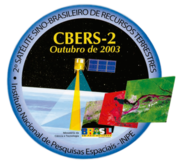CBERS-2
| Mission type | Remote sensing |
|---|---|
| Operator | CNSA / INPE[1] |
| COSPAR ID | 2003-049A |
| SATCAT no. | 28057 |
| Mission duration | 2 years[2] |
| Spacecraft properties | |
| Spacecraft type | CBERS |
| Bus | Phoenix-Eye 1[1] |
| Launch mass | 1,450 kg (3,200 lb)[2] |
| Power | 1,100 watts[2] |
| Start of mission | |
| Launch date | 21 October 2003, 03:16 UTC[3] |
| Rocket | Chang Zheng 4B |
| Launch site | Taiyuan Satellite Launch Center LC-7 |
| End of mission | |
| Disposal | Decommissioned |
| Deactivated | Late 2007 |
| Orbital parameters | |
| Reference system | Geocentric |
| Regime | Sun-synchronous |
| Semi-major axis | 7,152.64 km (4,444.44 mi) |
| Eccentricity | 0.0001886 |
| Perigee altitude | 780 kilometres (480 miles) |
| Apogee altitude | 782 km (486 mi) |
| Inclination | 98.17 degrees |
| Period | 100.33 minutes |
| Epoch | 1 December 2013, 03:03:10 UTC[4] |

| |
China–Brazil Earth Resources Satellite 2 (CBERS-2), also known as Ziyuan I-02 or Ziyuan 1B, was a remote sensing satellite operated as part of the China–Brazil Earth Resources Satellite program between the Chinese Center for Resources Satellite Data and Application and Brazilian National Institute for Space Research.[1] The second CBERS satellite to fly, it was launched by China in 2003 to replace CBERS-1.[3]
CBERS-2 was a 1,450 kg (3,200 lb) spacecraft built by the China Academy of Space Technology and based on the Phoenix-Eye 1 satellite bus.[1] The spacecraft was powered by a single solar array, which provided 1,100 watts of electricity for the satellite's systems.[2][5] The instrument suite aboard the CBERS-2 spacecraft consisted of three systems: the Wide Field Imager (WFI) produced visible-light to near-infrared images with a resolution of 260 m (850 ft) and a swath width of 890 km (550 mi); a high-resolution CCD camera was used for multispectral imaging at a resolution of 20 m (66 ft) with a swath width of 113 km (70 mi); the third instrument, the Infrared Multispectral Scanner (IMS), had a resolution of 80 metres (260 ft) and a swath width of 120 km (75 mi).[6]
A Chang Zheng 4B carrier rocket, operated by the China Academy of Launch Vehicle Technology, was used to launch CBERS-2. The launch took place at 03:16 UTC on 21 October 2003, using Launch Complex 7 at the Taiyuan Satellite Launch Center.[3] The satellite was successfully placed into a Sun-synchronous orbit.[7]
Following the launch of CBERS-2B in 2007, CBERS-2 was retired from service.[2] As of 1 December 2013, the dericict satellite remains in orbit, with a perigee of 780 km (480 mi), an apogee of 782 km (486 mi), 98.17 degrees inclination and a period of 100.33 minutes. Its orbit has a semimajor axis of 7,152.64 km (4,444.44 mi), and eccentricity of 0.0001886.[4]
References
[edit]- ^ a b c d Krebs, Gunter. "CBERS 1, 2, 2B / ZY 1A, 1B, 1B2". Gunter's Space Page. Retrieved 1 December 2013.
- ^ a b c d e "CBERS-1 (China-Brazil Earth Resources Satellite) - 1st Generation Satellite Series". Earth Observation Portal. European Space Agency. Retrieved 1 December 2013.
- ^ a b c McDowell, Jonathan. "Launch Log". Jonathan's Space Page. Retrieved 1 December 2013.
- ^ a b "CBERS 2 Satellite details 2003-049A NORAD 28057". N2YO. 1 December 2013. Retrieved 1 December 2013.
- ^ "CBERS-1, 2 and 2B Description". INPE. Archived from the original on 20 January 2014. Retrieved 1 December 2013.
- ^ "CBERS-1, 2 and 2B Cameras". INPE. Archived from the original on 20 January 2014. Retrieved 1 December 2013.
- ^ "UCS Satellite Database". Union of Concerned Scientists. Archived from the original on 9 September 2010. Retrieved 1 December 2013.